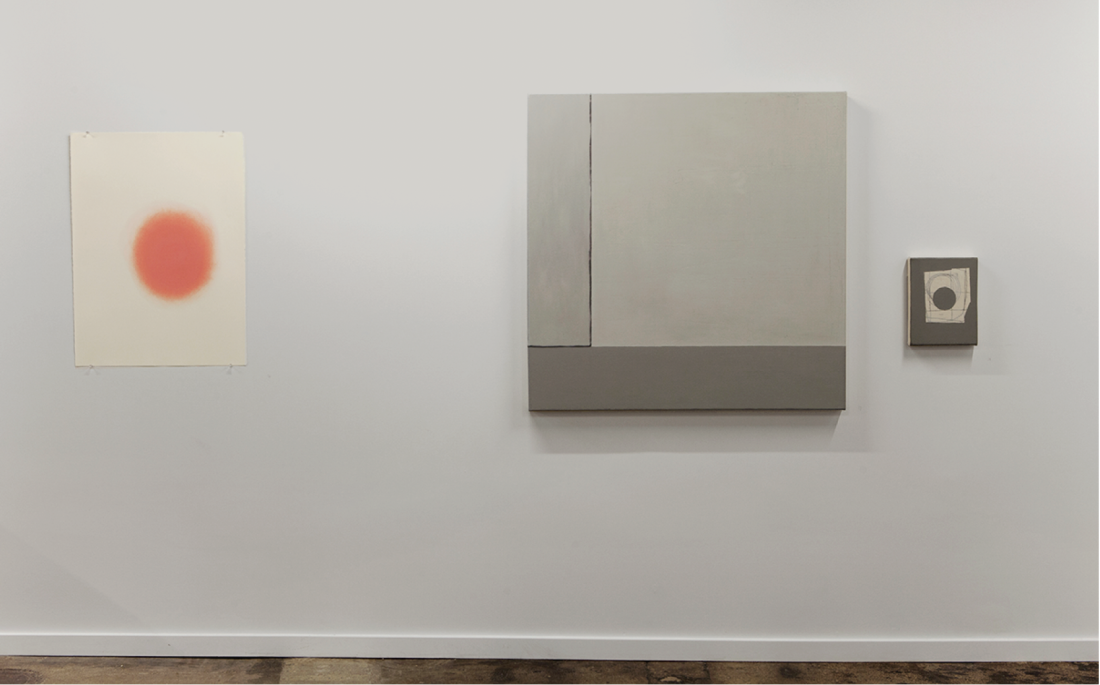Derek Dunlop
In Chromophobia (Reaktion Books, 2000) David Batchelor states, “To fall into colour is to run out of words.” Accepting colour as the last stop for language becomes a demonstrative exercise when writing on Derek Dunlop’s exhibition, “End-Forms.” In describing the viridescence of pale washes, eyesome swathes of creamy, flat paint, and tussles of prints swiped energetically across receptive canvas, I already feel I am failing the work. I visited the windowless gallery several times over the course of the show, met with the artist, took photos with my phone and requested a gallery list with images. To my delight all these elements were inadequate for capturing the exhibition. The last visit I just spent looking; making notes on colour, on textures, and all with a nagging feeling of being unable to articulate what I was seeing. Colour shifted on a suspicious continuum, from elegance to queasiness; it is hard to stray from colour’s storied history in art, from Kazimir Malevich’s black square to International Klein Blue. However, colour has a history both in and outside of canons and across disciplines, a point I reflected on throughout “End-Forms.”
Thinking through histories of colour and its delivery through paint, it is worth noting Dunlop’s time at the Golden Residency in central New York in 2014. Located next to the Golden Artist Colors manufacturing facility, the residency brings paint technology and artists together for a greater understanding of the ability of pigment and bindings to express and experiment with colour. One of its products, Williamsburg Handmade Oil Colors, is produced in small batches and hearkens back to the way paint was made for artists in France in the late 19th century. Each colour has a specific grind and capacity best shown in “End-Forms” through the work Colour Chart, 2015. Rather than a smooth wheel of pleasing shifts, the painting celebrates dissonance through its gritty and smooth pairings in texture and tint. It is difficult to speculate for whom this colour chart in its discordant construction would serve. Dunlop’s specificity is marked in contradistinction to a segment of contemporary painting that sources industrial and commercial house paints for its ends; the comparison is refreshing.

Installation view, “End-Forms,” 2015, Lisa Kehler Art + Projects, Winnipeg. Photograph Karen Asher.
Formally, Dunlop’s particular nuances in abstraction could be easily missed on initial scans: a thread of squares in rectangles, a commitment to using handmade oil paints and making express material choices to establish figure and ground relationships, all require close looking. Stepping back from the gallery walls allows a word with the concrete floor. A circle on the floor answers a halo on the wall, static globs of uneven measure draw the eye up and across a canvas with light, thick fingers of paint, and a half exposed, embedded metal grid contrasts quietly with a painting of soft bleeds where the demarcations are hushed and smudged.
Promise, 2015, could be considered hopeful with its three varied squares of cheerful pinks. Resembling a flag, it might be coded or co-opted for a cause but the light on the painting shifts and a wisp of blue creeps in slightly, suffocating any ideals underneath. Another painting entitled Cherish, 2015, evokes a grotesque melange of skin tones in a square with a slight orifice-like slit across its surface. It repels and fascinates as the eye tries to identify and assimilate its relationship to the rectangle of slight putrescence alongside it. The painting resists and slips away, an attribute that permeates most of the artwork in the show.

Derek Dunlop, Colour Chart (in search of desire), 2014, oil on paper, 30 x 22.5 inches. Photograph Karen Asher.
Study for End-Forms, 2015, is similarly deliberate in its register of drawings and found items arranged horizontally and with considered display. There is a measured tension of what is made visible and what remains invisible across the table. In both the drawings and found items there is a sense of becoming: from rubbings and incisions to the marks on paper that reveal as much as they attempt to conceal. Even the pressed Philadelphia Fleabane in plastic and a slab of found wood seem embodied with unknown histories. Crucially their original selection feels stumbled upon in a marked moment, a register of meaning as objects with the potential to record, much like the collection of Mason ledger rubbings on found paper positioned on another small table. Their status as record keepers is transformed from the expected numbered lists and journal entries to a form that traces a different representation of time.
The choices of found paper from old notebooks and the aforementioned ledger pages create a sense of mysterious temporality. This is not limited to the works on found paper but also through the relationship between drawings and paintings arranged in the show. Avoiding nostalgia, Dunlop’s choices feel more like they are from another time. One that is familiar but not necessarily known. It’s like finding a notebook lovingly used in your youth with someone else’s writing in it. ❚
“End Forms” was exhibited at Lisa Kehler Art + Projects, Winnipeg, from November 5 to December 5, 2015.
Courtney R Thompson is an arts writer living in Winnipeg.

